
|
Sale 30
Manuscript and Collectibles Auction
| Lot |
Photo |
Description |
Realized |
Lot 1769 |
 |
Lion (Goddess) - A Splendid Amulet in Faience. Egypt, Third Intermediate Period, c. 1090-675 BC. The goddess sits on a throne with open work sides showing Nehebka and a uraeus. She has the full-maned head of a male lion, and the slim body of a woman, and is clad in a form-fitting dress, and a lappet wig. In one hand she holds a sistrum. A large amulet -- it is intact and perfect, with green to slightly blue-green glaze, heightened with splashes of black. Height: 2-7/16". A choice example of this sought after amulet type.
Estimated Value $2,500 - 3,500.
Carol Andrews notes in her Amulets of Ancient Egypt, that this type can represent any number of goddesses and so is difficult to attach any particular name to them. However, the presence of the sistrum links it to older representations of Bastet, the cat goddess. Yet still, "…. identical figures are identified as Sekhmet, the fierce goddess of the Memphite area, who symbolized the burning heat of the sun and, as the sun-god's vengeful eye, destroyed his enemies and brought plague and pestilence."Andrews illustrates two closely similar examples in figure 30, a & d.
View details and enlarged photo
| Realized
$2,875 |
Lot 1770 |
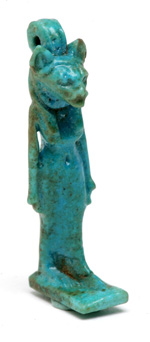 |
Lion-Headed Sekhmet - Blue-glazed Faience Amulet. Egypt, 21st/26th Dynasty, c. 1075-525 BC. The war goddess depicted as draped and bewigged slim woman with the head of a lion. She stands with one foot forward, hands at sides. The amulet finely and carefully detailed, with splendid dark turquoise to deep blue-green colored glaze. Intact and choice. This what an amulet should look like! Height: 1-9/16".
Estimated Value $850 - 1,250.
View details and enlarged photo
| Realized
$863 |
Lot 1771 |
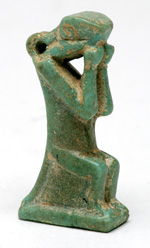 |
Serpent Deity, Nehebka - In Finely Glazed Faience. Egypt, 26th Dynasty, 664-525 BC. The god is depicted as a nude man, with tail and serpent head, in seated position -- propped up by his tail. Both hands are raised, and clenched before his chin. Intact and perfect, with handsome turquoise green, to almost apple green, glaze. Some cleanable earthen deposits. Choice. Amulets of Nehebka are uncommon. Height: 1-7/16".
Estimated Value $500 - 750.
The name Nehebka means "he who harnesses the spirits." As a serpent god, he was regarded as a benign and peaceful being. His original function was to act as an intercessory on behalf of the deceased king, who was being judged for admission to the Underworld. Cf. Petrie, Amulets, no. 254.
View details and enlarged photo
| Realized
$489 |
Lot 1772 |
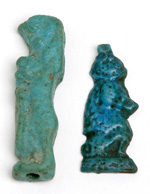 |
Baboon & Falcon - Two Amulets in Blue Faience. Egypt, New Kingdom and Late Period, c. 1250-350 BC. From the New Kingdom or early Third Intermediate Period, a seated baboon in profile, with lunar and solar crown on head; molded with a deep blue-green to azure-glazed faience. Typical of amulets of this period, the pendant's loop hanger was formed from a tubular bead, attached during the firing process. Later, around 27th-29th Dynasties, a molded image of Qebehsenuef, a funerary deity and one of the Sons of Horus. With falcon head, he stands left, draped in long raiment. Both pieces intact and very well preserved. Heights: 1-1/4"; 1-9/16". Lot of 2 items.
Estimated Value $300 - 400.
View details and enlarged photo
| Unsold |
Lot 1773 |
 |
Siren - Black-figure Aryballos. Greece, Corinth, early 6th century BC. Small araballos in buff ware, with creme slip and black-figure designs, partly heightened with red. The main figure is a fantastic creature, a siren -- with the head of a woman on the body of a bird. She stands with wings spread and head reverted. Additional designs consists of circular rings, tongue pattern at neck, and a row of petals along the vessel's rim. Araballos neatly preserved, with some fading or minor losses to paint. Height: 2-3/8".
Estimated Value $350 - 450.
View details and enlarged photo
| Realized
$437 |
Lot 1774 |
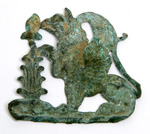 |
Griffin - Stylish Applique in Molded Bronze Sheet. Greece, perhaps Northern, c. 5th - early 4th century BC. The nicely detailed sheet applique depicts a griffin, with curved wing, seated left, with one paw raised to a stylized acanthus plant before it. Its beak against the plant's flower. The griffin's physique is robust and stout. Two piercings show where it was attached. Also on the back, small fibers are still visible from the cloth on which it lay. Metal well preserved with thin greenish and earthen patina. Size: 2-1/8 x 2-1/4".
Estimated Value $350 - 450.
Ex Superior Auction (6-2/3-98), lot 6087. Compare May's Period IV coins of Abdera for type and style.
View details and enlarged photo
| Realized
$460 |
Lot 1775 |
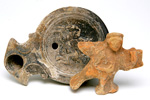 |
Siren & Pegasus - Terra Cotta Figurine & Lamp. Greece & Rome, c. 400 BC. - 150 AD. Another pair of fantastic creatures. One, a molded small siren figurine, in reddish-orange ware. In this version, with the head and upper torso of a woman, on the body of a bird. She stands with wings spread, holding a flower to her breast. Sharply molded, but somewhat worn, with losses to wing tips. Likely Sicily, 5th century BC. Additionally, a Roman lamp with volute nozzle and flying Pegasus in discus. Maker's mark of a"T" on base. Intact, with much of brown glaze remaining, and some calcareous patina. Lengths: 3"; 4-1/8". Lot of 2 items.
Estimated Value $300 - 400.
View details and enlarged photo
| Realized
$403 |
Lot 1776 |
 |
Lions versus "Master of Animals" - in Cast Bronze. Iran, Luristan, c. 800-600 BC. The figural group consists of a stylized male figure, janiform and of tubular form, grasping flanking roaring lions. The animals and deity share common legs at the bottom. With original green and earthen patina, and perhaps a discreet repair at one arm. Accompanying this object, a narrow, bottle-like base, which probably supported the demon and animals group on the end of a pole. A good example of this popular antiquity. Height overall: 13-1/4".
Estimated Value $500 - 750.
For related, but more elaborate examples of this "classic" Luristan bronze artifact, see Moorey et al, Ancient Bronzes (Heeramaneck Collection), 236 ff.
View details and enlarged photo
| Unsold |
Lot 1777 |
 |
Lion - Plaque/Bead in Deep Blue-glazed Faience. Roman Egypt, 1st-2nd century AD. The faience molded as a lion reclining, with head between paws, on a thick, rectangular base. The lion well detailed and handsome. The blue mostly well preserved, with touches of iridescence at bottom of lion and along sides of base. Usually encountered badly preserved, this example remarkably fine. Rare thus. Length: 1".
Estimated Value $300 - 450.
View details and enlarged photo
| Realized
$345 |
Lot 1778 |
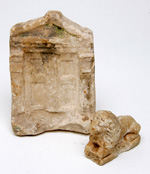 |
A Lion and a "False Doors," Carved in Stone. Egypt, Ptolemaic and Roman Periods, c. 200 BC. - 200 AD. The earliest are the "doors," which are a small tablet carved in limestone, showing two simple panel doors, flanked by two stepped pillars, all beneath a triangular and carinated pediment. Some chipping to the bottom of the tablet, but overall nicely preserved, with remains of the original green paint clearly evident in the pediment and base beneath the doors, and faint ocher on one pillar. Surviving miniature Ptolemaic doors, such as these, are rare. Accompanying this is a charming recumbent lion, Roman, in a crystalline alabaster or marble. Simply, but neatly modeled, and well detailed, the lion (likely an amulet) lays on a rectangular plinth, with paws forward and head erect. Lion's forepaws and leading edge of base are missing, otherwise lion intact, with scattered chips over base. Amulets of this type became popular in the Late Period, and were protective to the wearer. Size of Door: 3-7/8" x 2-1/2"; Lion: 1-1/2" x 2". Lot of 2 items.
Estimated Value $1,500 - 2,500.
In almost every temple and tomb in Ancient Egypt simple niches were carved to look like doorways set in solid walls. While no rooms lay immediately behind them, they were frequently aligned with the inner chambers of the structure. These "false doors," as Egyptologists have come to call them, were magical portals between the world of the living and that of the dead. They allowed the Ka, or spirit, of the deceased to leave the burial chamber and enjoy the offerings and ritual nourishment left by the priests and family members that was indispensable to existence of the Ka after the death of its body. False doors were also used in temples to facilitate contact between mortals and the gods. For similar reasons, false doors were painted on the sides of coffins as well as on the cabinets holding the magical servants known as "ushabtis".
View details and enlarged photo
| Unsold |
Lot 1779 |
 |
Lion (Head) - Boldly Carved in Dark Gray Stone. Roman Egypt, c. 2nd - early 3rd century AD. A sizable carving, fashioned in a slightly green-tinged dark gray basalt or graywacke. The lion with somewhat frowning expression and mouth agape. The sculpting material apparently hard, so that the detail is kept simple, yet forceful. Perhaps once part of a cista or sarcophagus. Height: 6-1/4", on custom stand. A wonderfully expressive fragment!
Estimated Value $4,500 - 6,000.
Arte Primritivo, NY.
View details and enlarged photo
| Realized
$5,520 |
Lot 1780 |
 |
Lions & Bird - Buckle and Pendant in Silver. Caucasus or Central Asia, c. 450-950 AD. Lot of two silver items. First an ornate buckle or pendant in cast silver, showing heavy fire gilding. Buckle comprised of two symmetrical roaring lions, who curve forward to almost meet each other. At their feet, forming the belt attachment, two seated griffins. With moderate wear, and a fair amount of gold remaining on the lion's backs. Buckle perhaps Hunnish, 5th-7th century. The second item a fowl in flight, with short beak and cockscomb. Pattern of bird's feathers indicated by a tremelo engraving on the underside; the dorsal side with deep channels, perhaps for enamelling. In good condition. Later Migration Art, somewhat reminiscent of Avar products. Lengths: 1-3/8"; 1-1/2".
Estimated Value $350 - 500.
View details and enlarged photo
| Unsold |
Lot 1781 |
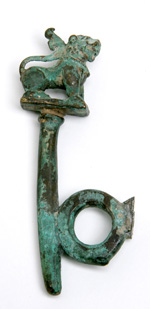 |
Lion - Handle from a Brass Vessel. North India or Iran, c. 16th-17th century. The handle consists of a ring (showing signs of attempted re-attachment to the vessel with solder), and an upright rod, with finial atop, having seated heraldic lion. The stylized lion of stocky proportions, and showing a foliate tip to his tail, and a curled mustache to his muzzle. A chain with bell pendant hangs from his neck. Handle exhibits modest wear, with light crusty green or earthen patina. Height: 5-1/8". Amusing characterization.
Estimated Value $300 - 400.
View details and enlarged photo
| Unsold |
Lot 1782 |
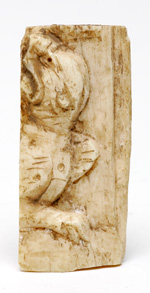 |
Panther - Carved in Bone. Roman Egypt, Alexandria, c. 200-350 AD. Fragment of a carved scene with Dionysus standing, his panther resting below at his feet. As preserved, the panther crouches to the ground, with his head up and turned back to regard the god. Neat, careful work for the period; the bone in very fine condition. Size: 1-7/8" x 7/8".
Estimated Value $300 - 400.
View details and enlarged photo
| Unsold |
Lot 1783 |
 |
Egyptian Cat - A Charming Amulet in Bronze. Egypt, 26th - 30th Dynasty, c. 664-342 BC. The cat sits erect and alert, on a cartouche-shaped base, with its tail curled forward to the right forepaw. Integral to the a base is a lengthy tapering tenon -- indicating this object was intended to be set into a base of some sort, to be viewed rather than worn. The body simply but accurately characterized, the head neatly done, with typical cat "smile." At the back, twin rings comprise a suspension loop. Item overall sharp and well preserved, with pleasing variegated red, brown, and green patina. Height: 3", mounted on walnut base. A delightful and unusual version of one of ancient Egypt's most popular artifacts.
Estimated Value $3,000 - 4,500.
Of all the fearsome, maned, lion-headed goddesses, only Bastet transformed/evolved into the less terrifying household cat. And because of the cat's ability to have several litters of kittens a year, Bastet acquired the traits of a fertility goddess. In addition, she was already associated with the sistrum (a musical instrument), so she also become a patroness of festivity. The numerous amulets of a seated or recumbent cats with kittens would indicate these were worn by women to enhance their own fertility.
View details and enlarged photo
| Unsold |
Lot 1784 |
 |
Bull's Head - Ornate Bronze Pendant. Iran, Luristan, c. 800-650 BC. An extraordinarily large head pendant (bucranium), the anatomical details of the bovid rendered with intricate geometric patterning. A casting flaw noticeable on the forehead, plus a few chips to the patina, but otherwise intact, and as found. The patina a dark green, with some lighter areas, and some spots of black-green. Length: 2-1/4". Rare.
Estimated Value $350 - 450.
A heavy, large pendant such as this would very likely have been worn by an animal, perhaps the herd's chief bull itself.
View details and enlarged photo
| Realized
$201 |
Lot 1785 |
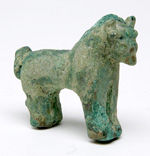 |
Bull - Cast in Bronze. Western or North Iran, or Central Asia, perhaps 800-600 BC. The stocky-proportioned creature stands with feet close together. Its face is small and triangular, with heavy brow modeled as a thick horizontal ridge. One of the circular-bored eyes still contains the remains of an inlay (shell?). Variegated crusty green patina, with some additional copper adhesions. Length: 2-1/8". Piece may belong instead to the Parthian Era.
Estimated Value $350 - 550.
View details and enlarged photo
| Unsold |
Lot 1786 |
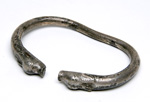 |
Calf Heads - Cast and Chased Silver Armlet. Achaemenid Iran, 5th century BC. The penannular armlet of typical distinctive form. Each finial modeled as the head of a young calf, with large upturned eyes. Behind the heads are incised collars, with further details added to the chin, ears, and muzzle. Armlet with areas of black patina, and a few spots of copper encrustation. A delightful artifact, robust and solid, and still wearable. Width: 3-1/8".
Estimated Value $600 - 950.
View details and enlarged photo
| Realized
$345 |
Lot 1787 |
 |
Cattle & Goat - Molded in Terra Cotta. China, Han Dyasty, c. 206 BC. - 220 AD. A pleasing group of three mold-formed animals, with two in red-orange ware (a standing bull and recumbent goat), and one (a recumbent bull), in gray ware; and all with additional colored slip on top. Each in pleasant style. In addition, an amusing stylized seated dog, hand-detailed, with deep ochre glaze. Likely Ming or later. Finely preserved, with some calcareous patina on back (sea salvage?). Heights: 4-1/8" - 6-1/4". Appealing material. Lot of 4 items.
Estimated Value $400 - 600.
View details and enlarged photo
| Unsold |
Lot 1788 |
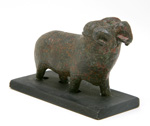 |
Sacred Ram - with Four Heads, in Bronze. Egypt, Late Dynastic, c. 650-350 BC. This plump animal strides forward, viewing the world from two pairs of addorsed heads. The lower legs of the creature are now lost, otherwise ram is sharp and well preserved, with pleasing variegated red, brown, and green patina. Length: 2-11/16"; mounted on wood base.
Estimated Value $3,500 - 4,500.
The type is generally uncommon among ram-figured amulets, and rare in bronzes. Cf. a very similar example, in blue faience, once in the Christos Bastis Collection: Sotheby's, New York, Christos G. Bastis Collection (12-9-99), lot 40. Carol Andrews, in her Amulets of Ancient Egypt, was uncertain as to which Ram god this four-headed version might be the embodiment of. "It might be associated with the cult of the god known simply as the 'Ram of Mendes'…. Elsewhere the four-headed ram is associated with Osiris and Re, as well as with other deities…."
View details and enlarged photo
| Unsold |
Lot 1789 |
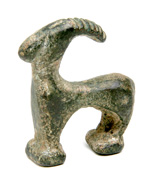 |
Ibex (Goat) - Figurine in Bronze. Iran or Central Asia, c. 6th-10th century AD. Simple but stylish figure of the caprid, standing with legs together, with large, ridged, and recurved horns atop its head. Grooves delineate details of the face and tail. Well preserved, with brown to dark green patina, and areas of earthen deposits. Height: 2-1/16". A pleasing object, perhaps a handle to a disc mirror, at home both in the worlds of ancient and modern art.
Estimated Value $250 - 350.
View details and enlarged photo
| Unsold |
Lot 1790 |
 |
Antilope (Head) - On Elegant Ladle Handle in Bronze. Hellenistic, c. 200-100 BC. The handle to a ladle (kyathos) of narrow plank-like form, with grooved and raised rims, flaring corners at top, and spread arms at base, which would once have held a separately attached bowl. The handle's finial a charming and nicely detailed head of an antelope, with short prong-like horns. Intact and quite pristine, with handsome glossy green patina. Length: 9-7/8".
Estimated Value $500 - 750.
Cf. Hayes, Greek, Roman, and Related Metalwork in the Royal Ontario Museum, pp. 40-45.
View details and enlarged photo
| Unsold |
Lot 1791 |
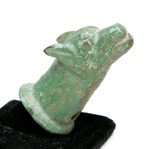 |
Dog (Head) - Rome, Eastern Europe, 3rd-4th century AD. Simply but neatly modeled head of a dog in bronze, as the socket fitting to a pole or rod, with two holes for securing pin. Intact and well preserved, with attractive green patina. Length: 2".
Estimated Value $200 - 350.
View details and enlarged photo
| Unsold |
Lot 1792 |
 |
Dog - In Red-glazed Ceramic. Western Mexico, Colima, c. 200 BC. - 300 AD. A large and finely crafted "red" dog, standing with teeth bared -- almost smiling. The dog of somewhat robust build, but with short legs, and an immensely bloated abdomen. The details of the eyes and teeth are incised. Repairs at neck and legs, with probable restoration to some of the feet. The glaze well preserved, with considerable remains of black organic encrustations. Length: 14-5/8". An imposing and eye-catching example of this very popular, and collectible, antiquity.
Estimated Value $1,250 - 1,950.
Dogs were revered and respected in ancient Mexico's Indian culture. The "Colima Dog," a distant relative of the Mexican Hairless and the Chihuahua, may have been a pet, or it may have been fattened for eating -- or both! Among the early colonial immigrants, a Jesuit Priest, "Sahagún," examined and wrote of the things concerning the "new" lands of America. Regarding these dogs of Colima, which are generally portrayed as quite fat, even grotesquely so, but many of which have happy faces, he says, "The dogs of this land have four names, called: Chichi, Itzcuintli, Xochiocoyotl, Tetlamin; and also tehuizotl…. They raise other dogs that they call Xoloitzcuintli with no hair at all…. There are other dogs that are called tlalchichi, short and round, that are very good to eat".
It is believed that the hairless dogs, the Xoloitzcuintli, represented the god Xolotl, who had the task of guiding the dead on their journey to "Mictlan," that is, the Spirit World. The Aztecs believed that in order for the souls of the dead to reach "Mictlan" they had to cross the black river "Apanoayan", as well as overcoming other obstacles, and these hairless Xoloitzcuintlis had the task of guiding their human masters across this river, along with helping them overcome all the other difficulties on the journey. It is said that these red-colored dogs became the chosen guide because for a black dog to the perform the task, it was found to be difficult to distinguishing its black shape on a black river, in the murky underworld. When a white dog was approached as a substitute, that dog refused because it didn't want its coat soiled by the dark waters. The red dog then stepped up to the task and performed it well.
An affirmation of this mythology of the Colima dog is the fact that these statues were always found in graves sites and nowhere else. In essence the pottery dogs were an article manufactured strictly for funerary use.
View details and enlarged photo
| Realized
$1,840 |
Lot 1793 |
 |
Mouse - Finely Crafted Study of Crouching Mouse in Bronze. Rome, 1st-2nd century AD. The mouse, with tail tucked under, sits slightly raised on its hind legs, and once held a morsel in its now missing paws. Some fissures and pits in the metal, otherwise as found, and intact, with pleasing green patina. Length: 1-7/8".
Estimated Value $350 - 450.
The Romans apparently delighted in the almost human antics seen among mice. The subject figures frequently in such small personal objects as the above bronze. Likewise, in the decorative and minor arts, mice are often seen stealing food from the table, sometimes tormenting or teasing roosters, or even driving chariots (sometimes riding in one, and pulled by an elephant!).
View details and enlarged photo
| Realized
$575 |
Lot 1794 |
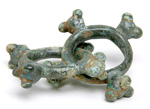 |
Stylized Animal Heads(?) - Rare, large Interlinked Ring Money in Bronze. Celtic Eastern Europe. Danube Region, c. 3rd-1st century BC. Each ring with four globular protrusion, each of which support three smaller globules, the whole rather suggestive of stylized dog heads. On one ring, all the "heads" are oriented in the same direction, while on the second, two heads look clockwise, and the other two, counterclockwise. Choice condition, with attractive deep green patina. Large, linked rings of this size are Extremely Rare. Diameters average 2-1/2". Said to be from the southwestern Carpathian area.
Estimated Value $300 - 450.
View details and enlarged photo
| Realized
$173 |
Lot 1795 |
 |
Assorted Animals - A Handsome Display of Animal Objects from the Ancient World. Various Cultures, c. 1500 BC. - 300 AD. Thirteen animal heads or figures are attractively mounted on linen, within plexiglass box. The animal most represented is the horse: with a quite fine Roman circular brooch in bronze; a choice head from a full figurine, fairly early Egypto-Roman; and a simple, but sympathetic wood carving of a walking horse, probably Roman Egypt, c. 2nd AD. Also included is an especially bold molding of a lion mask. Other heads include Syro-Hittite heads of uncertain creatures, and perhaps one or two Pre-Columbian heads. Most pieces fragmentary, but well preserved. Framed size: 15-3/8" x 20-1/2".
Estimated Value $650 - 850.
View details and enlarged photo
| Unsold |
Lot 1796 |
 |
A Herd of Animals - Iran, Luristan & Amlash, c. 1000-700 BC. A small herd of miniature animals, comprised of two horses, a goat, a bull, and perhaps a sheep. All pleasing characterizations, much above average for this type of material. Three with either piercings or suspension loop for stringing. All intact and well preserved, with a variety of patinas. Lengths: 1-5/8" - 2-3/4". Good lot. Lot of 5 items.
Estimated Value $500 - 750.
View details and enlarged photo
| Realized
$300 |
Lot 1797 |
 |
Another Herd of Animals - in Terra Cotta. Mainly Magna Graecia, c. 4th century BC. - 1st century AD. A group of molded votives or child's playthings. A variety of creatures, including: two tortoises, with segmented carapace. Both appear to be from the same mold. Also, a boar with ruff of bristles along spine, in a creme to light orange ware. Plus a sleeping hound, of lanky form, with long floppy ears, in addition to a cockerel in fighting pose. Probably from Ptolemaic Egypt, two seated Maltese-like dogs, one with head turned to side. Lastly a bull, perhaps Graeco-Roman, likely from the Asia Minor. The cock worn, the Maltese dogs with slight chipping to ears. Lengths: 2-7/8" - 4". A fun assemblage. Lot of 8 items.
Estimated Value $650 - 1,000.
View details and enlarged photo
| Unsold |
Lot 1798 |
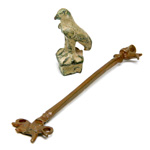 |
Eagle & Bird - Fashioned in Bronze and Brass. Rome, c. 2nd century AD.; Byzantium, c. 10th century AD. The stalwart Roman eagle realistically modeled, with an emphasis on the size and power of its talons, stands on a rectangular base or altar. Well preserved, with green and earthen patina. Height: 1-1/2". This object likely part of the personal altar of a soldier. The Byzantine brass, simpler and stylized, the handle from a spoon or cosmetic utensil. Its finial is formed by a bird with rather large head and protuberant eyes. Height: 4-3/8".
Estimated Value $300 - 400.
View details and enlarged photo
| Unsold |
Lot 1799 |
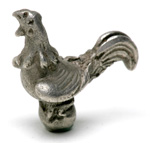 |
Cockerel - Silver Finial to a Pin. Rome, 1st-2nd century AD. The bird rests on a globe, which was once the top of an ornate silver hair pin. The fowl carefully and sympathetically modeled, with added incised and punched details. The piece shows a little handling wear, but otherwise is well preserved. Height: 7/8". A quality miniature sculpture in precious metal.
Estimated Value $300 - 450.
View details and enlarged photo
| Realized
$184 |
Lot 1800 |
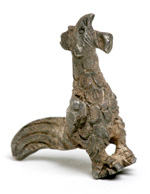 |
Cockerel - Carefully Detailed, in Silver. Rome, 2nd-3rd century AD. The bird perhaps once on a base, as a free standing sculpture, or maybe an element from an elaborate pin. The rooster's stretching pose as it is about to crow is carefully observed. The modeling is precise and very detailed, with added incised and punched details. The piece is very nicely preserved. Height: 13/16". A splendid miniature.
Estimated Value $300 - 500.
View details and enlarged photo
| Realized
$184 |
Lot 1801 |
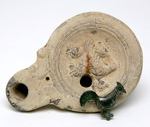 |
Rooster & Hen - In Bronze and Terra Cotta. Rome, 2nd-3rd century AD. A charming lot, consisting of a rooster brooch, and a lamp with hen and chicks motif. The rooster in silvered bronze, with niello decoration. Aside from slight losses to the bird's comb, foot and tip of tail, most of silvering and niello remains, along with the pin being intact on the reverse. The lamp in a beige-buff ware, with sharply molded discus showing a hen surrounded by four chicks. Lamp intact, with maker's name on reverse, and some traces of the lamp's dark brown glaze. Lengths: 1-1/4"; 4". Lot of 2 items.
Estimated Value $300 - 400.
View details and enlarged photo
| Realized
$345 |
Lot 1802 |
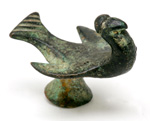 |
Goose(?) - Graceful Long-necked Bird, in Bronze. Roman-Byzantine, c. 400-800 AD. Small but artistic study of a bird standing with wings spread, its long neck arching back over the body. Stylized detailing, with notched eyes and angled grooves at the tail. Perhaps a thumbrest from a handle, or a grip for the lid of a lamp. Intact and sharp, and well preserved. Length: 1-1/2".
Estimated Value $150 - 300.
View details and enlarged photo
| Realized
$150 |
Lot 1803 |
 |
Dove - Charming Canosan Terra Cotta. Magna Graecia, Apulia, c. 340-250 BC. Later stylized molded figure of a dove, with tall, narrow neck and folded wings. In high fired tan-buff ware, covered with white slip and painted over with red for feather and beak details, along with ornament motif at breast in pink and blue. In fine condition, with earth deposits, and barely noticeable repairs to tail and neck. Length: 6-1/4"; mounted in custom lucite display box. A colorful example of an always popular antiquity.
Estimated Value $850 - 1,400.
View details and enlarged photo
| Unsold |
Lot 1804 |
 |
Another Dove - Charming Canosan Terra Cotta. Magna Graecia, Apulia, c. 340-250 BC. A mate to the preceding lot: with narrow neck and folded wings. In high fired tan-buff ware, covered with white slip and painted over with red for feather and beak, details, along with ornament motif at breast in pink and blue. In choice condition, with earth deposits, and barely noticeable repairs to head and tail. Length: 6-1/8". A fine display piece.
Estimated Value $800 - 1,250.
View details and enlarged photo
| Unsold |
Lot 1805 |
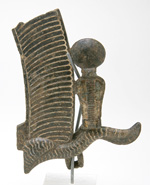 |
Sacred Cobra - The Uraeus, in Bronze. Egypt, 26th-27th Dynasty, c. 664-404 BC. Part of the side appendages to the atef crown from a large figure of Osiris. A finely detailed, stylized cobra with flared neck rises upright upon the horn of a ram, and leans against a large feather from an ostrich. The anatomy of the serpent well detailed, with the remains of a glass or metal inlay in one of the body segments. Likewise the patterning of the feather's vanes and the horn's ridges is neat and precise. The fragment in excellent condition, with black-brown patina. A very attractive object. Height: 4-1/8", on custom base.
Estimated Value $1,500 - 2,500.
View details and enlarged photo
| Realized
$1,725 |
Lot 1806 |
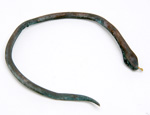 |
Snake - Fashioned in Silver and Gold. Graeco-Roman Egypt, c. 1st century BC. - 1st century AD. The snake is a hollow tube of silver, formed with a tapering tail and realistically modeled head. The deeply socketed eyes may have once held glass gems, or enamel. The creature's neck and throat with incised details of its scaly hide. At the nose and mouth, a piercing containing a small length of ancient twisted gold wire, probably set to represent the snake's forked tongue. Snake in quite fine condition, with only four small splits in its hollow body. Interestingly, the piece was obviously interred among bronze objects, which in the burial conditions deposited a thin coating of copper over the piece. The silver underneath it has been exposed in several spots. Widest diameter: 3-1/4". Interesting and rare.
Estimated Value $1,000 - 1,500.
View details and enlarged photo
| Unsold |
Lot 1807 |
 |
Caiman - Modeled in Copper or Bronze. Peru, Mochica/Chimu, c. 700-1430 A.D., or Inca, c. 1450-1530 A.D. A casting, almost like a thick bar, of a stylized depiction of a caiman. The reptile with short segmented tail, the scaly features of the head represented with some accuracy, while the patterning of the back displayed as a decorative herringbone design. The legs also exhibit some linear modeling; also clearly defined is the dentate patterning to the mouth. Intact, with mottled green patina over much of the object. Length: 8-3/8". Interesting, and a less common type of artifact seen from this area.
Estimated Value $400 - 600.
The lower basin of the Amazon extends into Peru, providing the country with several crocodilian species.
View details and enlarged photo
| Unsold |
Lot 1808 |
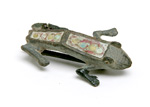 |
Frog - Roman Enamel and Bronze Brooch. Eastern Europe, c. 2nd - early 3rd century AD. The stylized creature with slim, angled body. Two panels along the back contain enamel, consisting of alternating yellow and blue granules within a red background. Brooch complete, with minor repairs to two feet. Enamel very well preserved; the metal with pleasing dusky green patina. Cute, and a less common brooch type. Length: 1-5/8".
Estimated Value $300 - 400.
Cf. a closely similar example, once Mildenberg collection, Christies London (10-26/27-04), lot 108.
View details and enlarged photo
| Unsold |
Lot 1809 |
 |
Fish - Carved Steatite Pipe. Chumash Indians, Channel Islands, California, c. 17th-19th Century. A sizable pipe fashioned from variegated brown-gray steatite, and modeled with relief eye-sockets, and both upright and angled dorsal fins. White shell appliques, with central piercing, have been applied with asphaltum in a line rimming the upper mouth, and down along each side. The fish swims with mouth wide open. A bone or shell tube comprises the pipe stem. Discreet repairs to the fins and rear end of the pipe, otherwise piece well preserved. Length: 12-1/2". Mounted on custom base. An important Chumash artifact.
Estimated Value $4,000 - 6,500.
Closely similar examples from the excavations carried out by E.K. Burnett, at Sequit Canyon, Malibu, near Los Angeles, California, can be seen on plate XVIII and frontispiece of his report, Inlaid Stone and Bone Artifacts from Southern California, Contributions Vol. XIII, Museum of the American Indian, Heye Foundation, New York, 1944. A copy of this journal accompanies this lot.
View details and enlarged photo
| Unsold |
Lot 1810 |
 |
Fish - A Choice Example from Oxyrhyncus, in Bronze. Egypt, Late Period, c. 664-342 BC. The Oxyrhyncus fish wears about its neck a broad collar of beads. On its head, a stylized crown of uraei with single large uraeus, topped by the crown of Hathor. The fish stands on a sled-like base, upon a rectangular plinth. The engraved details are neat and precise, with circular eye, and brow above, and with veining indicated in all the fins. This stylish sculpture is further enhanced by the lovely red-brown patina, with touches of red and green. Restoration noted to the forepart of the plinth, and perhaps one of the horns, and to a couple of surface faults on the sides. Nevertheless, this is a prime example, and one of the most attractive this cataloger has seen in years.
Estimated Value $2,000 - 3,500.
View details and enlarged photo
| Unsold |
Lot 1811 |
 |
Fish & Horse - In Silver and Bronze. Thrace, c. 300-100 BC., and c. 200-350 AD. Earliest, a finely crafted silver pendant of two hanging fish, somewhat akin to a carp or catfish in appearance. The integral loop folded over and soldered; the modeling of the fish careful, and neat. Toned, with minor calcareous deposits. Part of one tail fin re-attached, otherwise nicely preserved. Said to have been found in Bulgaria: Celtic Thrace. Second, in bronze, a Thracian "Rider God" on his high-stepping horse. Usual blocky style modeling. Horse re-attached to base, rider repaired at waist, with loss to left forearm. Otherwise, sharp, with dusky green patina. Heights: 2-5/16"; 2-7/8". Lot of 2 items.
Estimated Value $400 - 500.
View details and enlarged photo
| Realized
$288 |
Lot 1812 |
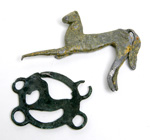 |
Horse & Goat - Celtic Gaul, c. 100 BC. - 200 AD. Earliest is the bronze belt fitting -- an open work design of a seated goat within a ring frame, with four loops at sides. Some linear chase work adds interest to the restrained, stylized design. But being Celtic, there is more than just one view to the piece. Rotating it 45 degrees turns the seated goat into a running or prancing horse. Some wear and losses to loops, but piece still crisp, with lovely dark green patina. Accompanying this, another horse, probably a votive, in lead, of graceful, swooping design. Part of one leg missing. Lengths: 1-5/8"; 2-3/8". Nice lot. Lot of 2 items.
Estimated Value $300 - 450.
View details and enlarged photo
| Unsold |
|
|